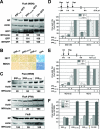Peptide-mediated interference with influenza A virus polymerase
- PMID: 17494067
- PMCID: PMC1933368
- DOI: 10.1128/JVI.00724-07
Peptide-mediated interference with influenza A virus polymerase
Abstract
The assembly of the polymerase complex of influenza A virus from the three viral polymerase subunits PB1, PB2, and PA is required for viral RNA synthesis. We show that peptides which specifically bind to the protein-protein interaction domains in the subunits responsible for complex formation interfere with polymerase complex assembly and inhibit viral replication. Specifically, we provide evidence that a 25-amino-acid peptide corresponding to the PA-binding domain of PB1 blocks the polymerase activity of influenza A virus and inhibits viral spread. Targeting polymerase subunit interactions therefore provides a novel strategy to develop antiviral compounds against influenza A virus or other viruses.
Figures



Similar articles
-
Involvement of Hsp90 in assembly and nuclear import of influenza virus RNA polymerase subunits.J Virol. 2007 Feb;81(3):1339-49. doi: 10.1128/JVI.01917-06. Epub 2006 Nov 22. J Virol. 2007. PMID: 17121807 Free PMC article.
-
Hsp90 inhibitors reduce influenza virus replication in cell culture.Virology. 2008 Aug 1;377(2):431-9. doi: 10.1016/j.virol.2008.04.040. Virology. 2008. PMID: 18570972
-
Crystal structure of the polymerase PA(C)-PB1(N) complex from an avian influenza H5N1 virus.Nature. 2008 Aug 28;454(7208):1123-6. doi: 10.1038/nature07120. Epub 2008 Jul 9. Nature. 2008. PMID: 18615018
-
The molecular anatomy of influenza virus RNA polymerase.Biol Chem. 1997 Jun;378(6):483-8. Biol Chem. 1997. PMID: 9224927 Review.
-
[Structure-function relationship of the influenza virus RNA polymerase subunits].Nihon Rinsho. 1997 Oct;55(10):2593-8. Nihon Rinsho. 1997. PMID: 9360377 Review. Japanese.
Cited by
-
A Novel Peptide from VP1 of EV-D68 Exhibits Broad-Spectrum Antiviral Activity Against Human Enteroviruses.Biomolecules. 2024 Oct 19;14(10):1331. doi: 10.3390/biom14101331. Biomolecules. 2024. PMID: 39456264 Free PMC article.
-
[New strategies for the development of antiviral molecules].Rev Francoph Lab. 2009 Dec;2009(417):91-100. doi: 10.1016/S1773-035X(09)70313-2. Epub 2009 Dec 11. Rev Francoph Lab. 2009. PMID: 32288807 Free PMC article. French.
-
Small molecule inhibitors of influenza A and B viruses that act by disrupting subunit interactions of the viral polymerase.Proc Natl Acad Sci U S A. 2012 Apr 17;109(16):6247-52. doi: 10.1073/pnas.1119817109. Epub 2012 Apr 2. Proc Natl Acad Sci U S A. 2012. PMID: 22474359 Free PMC article.
-
Cryptic proteins translated from deletion-containing viral genomes dramatically expand the influenza virus proteome.bioRxiv [Preprint]. 2024 Feb 7:2023.12.12.570638. doi: 10.1101/2023.12.12.570638. bioRxiv. 2024. Update in: Nucleic Acids Res. 2024 Apr 12;52(6):3199-3212. doi: 10.1093/nar/gkae133. PMID: 38168266 Free PMC article. Updated. Preprint.
-
TRIM32 Senses and Restricts Influenza A Virus by Ubiquitination of PB1 Polymerase.PLoS Pathog. 2015 Jun 9;11(6):e1004960. doi: 10.1371/journal.ppat.1004960. eCollection 2015 Jun. PLoS Pathog. 2015. PMID: 26057645 Free PMC article.
References
-
- Crescenzo-Chaigne, B., N. Naffakh, and S. van der Werf. 1999. Comparative analysis of the ability of the polymerase complexes of influenza viruses type A, B and C to assemble into functional RNPs that allow expression and replication of heterotypic model RNA templates in vivo. Virology 265:342-353. - PubMed
-
- Dostmann, W. R., C. Nickl, S. Thiel, I. Tsigelny, R. Frank, and W. J. Tegge. 1999. Delineation of selective cyclic GMP-dependent protein kinase Ialpha substrate and inhibitor peptides based on combinatorial peptide libraries on paper. Pharmacol. Ther. 82:373-387. - PubMed
Publication types
MeSH terms
Substances
LinkOut - more resources
Full Text Sources
Other Literature Sources
Miscellaneous

